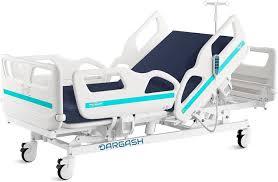Determining the cost of a hospital patient bed in Pakistan today is a vital consideration for hospitals, clinics, and healthcare buyers. Prices in the medical-equipment market reflect a range of features, build quality, and technical requirements. As healthcare in Pakistan expands and modernizes, understanding the current cost landscape for hospital-grade beds helps decision-makers make informed investments.
Why Hospital Bed Costs Vary Dramatically
Hospital patient bed price in Pakistan is not fixed; it depends on many factors:
-
Bed Functionality: Whether the bed is manual, semi-electric, or fully electric heavily influences its cost.
-
Build Materials: The type of metal and frame design — including stainless steel or reinforced alloy — affects durability and price.
-
Adjustable Features: Beds with adjustable head, foot, or total height, as well as Trendelenburg tilt, increase the base cost.
-
Safety and Support: Features such as side rails, locking wheels, and brake mechanisms add to price.
-
Mattress Quality: High-quality pressure-relieving or memory foam mattresses significantly raise the total cost.
-
Power Options: Electric beds often include backup battery systems or manual override to handle power outages.
-
Certifications: Beds built to international medical standards or with quality certifications may cost more.
-
Import vs Local Production: Imported beds generally cost more due to shipping and duty, while locally manufactured beds may be more affordable.
Current Typical Price Ranges for Hospital Beds in Pakistan
Based on market trends and supply-chain insights, here are approximate price ranges for hospital-grade patient beds in Pakistan today:
-
Manual Hospital Beds: These mechanically operated beds are the most basic and typically cost between PKR 20,000 and PKR 40,000. Hospitals that do not require extensive motorized positioning often use manual beds for general wards.
-
Semi-Electric Hospital Beds: These beds combine manual and electric controls, allowing for motorized head or foot section adjustment. Their approximate cost is PKR 45,000 to PKR 80,000, depending on the motor quality and features.
-
Fully Electric Hospital Beds: Beds that use motors to adjust height, head, and foot position are more advanced. Prices for these beds range from PKR 80,000 to PKR 150,000, depending on the brand, control panel, and safety features.
-
ICU / Critical Care Beds: These specialized beds are designed for intensive care units and come with features such as electronic tilting, built-in scale, side rails, and more precise positioning controls. Their price usually starts around PKR 150,000 and can exceed PKR 300,000 for premium models.
-
Specialty Beds (Bariatric / Pediatric): Beds for bariatric patients or for children require custom design and reinforced frames. Pediatric beds may cost PKR 50,000 to PKR 120,000, whereas bariatric beds can range from PKR 120,000 to over PKR 250,000, depending on the weight capacity.
What Influences These Prices Right Now
Several current market forces affect the cost of hospital patient beds in Pakistan:
-
Import Costs & Duties: Fluctuations in currency value and import tariffs can raise the price of imported beds.
-
Manufacturing Overheads: Rising costs for raw materials, labor, and energy further affect local manufacturing of high-quality hospital beds.
-
Medical Demand: Increased demand for bed capacity — from hospitals responding to public health needs — has put upward pressure on supply and cost.
-
Regulatory Standards: Manufacturer costs rise when there is a need to meet stringent medical certifications, safety checks, and quality assurances for hospital-grade beds.
-
Logistics and Shipping: The cost of shipping and distributing large hospital beds across the country can add to final delivery costs, particularly in more remote regions.
How to Choose the Right Hospital Bed for Your Facility
To make a smart purchase, follow these practical steps:
-
Evaluate Clinical Needs: Determine whether you need standard ward beds, ICU beds, or specialty beds.
-
Define Your Budget: Balance cost with functionality — don’t overpay for adjustable features that aren’t required in all scenarios.
-
Inspect Materials and Build: Look for durable metal frames, well-finished welding, and corrosion-resistant surfaces.
-
Check Safety Features: Confirm that side rails, locking wheels, emergency overrides, and braking systems are reliable.
-
Test Adjustability Options: Try out electric controls, height adjustments, or tilt functions if available — they should be smooth and dependable.
-
Confirm Power Requirements: If using electric beds, ask about battery backup or manual override systems for power failures.
-
Supplier Reputation: Choose suppliers who provide after-sales support, spare parts, and warranties to ensure long-term reliability.
-
Consider Mattress Cost: Don’t forget to budget for a high-quality mattress if it’s not included with the bed.
Benefits of Investing in High-Quality Hospital Beds
Investing in the right hospital bed brings multiple advantages:
-
Improved Patient Comfort: Adjustable positions help relieve pressure points and promote better recovery.
-
Reduced Risk of Injury: Side rails and locking features reduce the chance of patient falls.
-
Better Care Efficiency: Motorized beds help nurses and caregivers reposition patients without physical strain.
-
Longer Bed Life: Durable beds with quality materials withstand frequent use and sterilization.
-
Regulatory Compliance: Certified hospital beds help facilities meet healthcare regulations and standards.
Conclusion
The current hospital patient bed prices in Pakistan reflect a broad spectrum, from modest manual options to advanced ICU-level beds. Knowing what influences these costs — such as material quality, adjustability, safety features, and certification — allows healthcare decision-makers to make informed purchases. By carefully matching clinical requirements with bed specifications, hospitals and clinics can invest in beds that improve patient care, ensure safety, and deliver long-term value.



